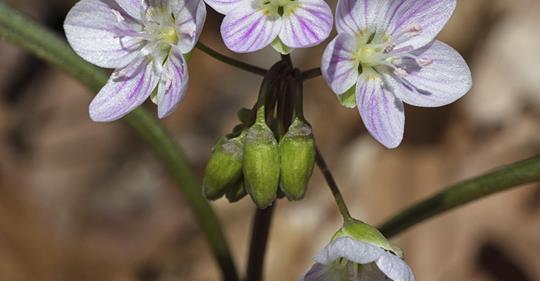
By Jim McCormac -- Article from Columbus Dispatch - Find full article HERE.
Spring steamrolls north at the rate of about 17 miles a day, leaving a wake awash in green growing things. The floral eruption commences in late February, when the odd flowers of the skunk cabbage thrust from the mire. However, the dam really bursts in April and floods Ohio’s landscape with flowers.
As I write this, the northern plains of Cleveland and Toledo remain unfruited, barren and snowy. Not so along the Ohio River Valley in our southernmost reaches. I was in Adams and Scioto counties on April 1, and wildflowers were busting out everywhere. Take heart, ye people of the northern lands — spring is headed your way and it’s unstoppable.
My visits to various botanical hot spots produced many hardy wildflowers in spite of the morning’s 25-degree frostiness. Dwarf larkspur, Harbinger-of-spring, hepatica, spring-beauty, Virginia bluebells and many others. Two rarities were on my hit list and both were in good floral spirits: goldenstar lily and snow trillium.
Lengthening days and warming soils stir wildflowers from their earthen beds. In the brief window between winter’s end and tree leafout, wildflowers run riot in sun-soaked woodlands. By mid-May or so, emergent leaves have tremendously reduced sunlight penetration to the forest floor, and the wildflower parade peters out.
“Wildflower” is a generic term, but is defined by Merriam-Webster as: “The flower of a wild or uncultivated plant or the plant bearing it.” Most of Ohio’s roughly 1,800 species of native plants would not be thought of as “wildflowers”, but of those that are, the spring wildflowers are the most eagerly sought.
Although the pure aesthetics of vernal flowers bring a joy in itself, these delicate plants do heavy ecological lifting. Legions of tiny bees, beetles, wasps and other insects sync their emergence with that of the flowers. Our native pollinators are often quite finicky about where they take nectar or pollen.
Oligolectic pollinating insects are those that are entirely wedded to one family, genus, or even a single species of plant. Many of our spring wildflowers support such insects. Golden ragwort, Jacob’s ladder, violets, waterleaf, wild geranium, and more all have their dependent specialists. No insect, no plant. No plant, no insect.
The caterpillars of various moths and butterflies, such as Leconte’s haploa moth and fritillary butterflies, feast on wildflower foliage. Only about one percent of these larvae will make it to the reproductive stage. The rest become food for birds and other animals. Nature’s hotdogs, you might say.
Ants play an enormous role in fostering spring flora. Many wildflowers’ seeds are appended with fleshy nutritious growths known as elaisomes. These vegetative steaks lure ants, which cart them off and, ultimately, leave the seed far from its source, thus spreading the plants about.
The above-ground parts of wildflowers ultimately wither and die, and their biomass contributes to building the rich soils of forests. Incomprehensively vast webs of fungi spread throughout this rich humus, forming the loamy framework from which other plants spring.
Spring wildflowers possess an intrinsic value to people that is not quantifiable. Imagine a natural landscape without them. Such a place would be soulless indeed.
The Ohio Division of Wildlife produces a wonderful primer titled Spring Wildflowers of Ohio. This 80-page booklet is free, and available by calling 1-800-WILDLIFE or emailing wildinfo@dnr.state.oh.us.
Naturalist Jim McCormac writes a column for The Dispatch on the first, third and fifth Sundays of the month. He also writes about nature at www.jimmccormac.blogspot.com.
